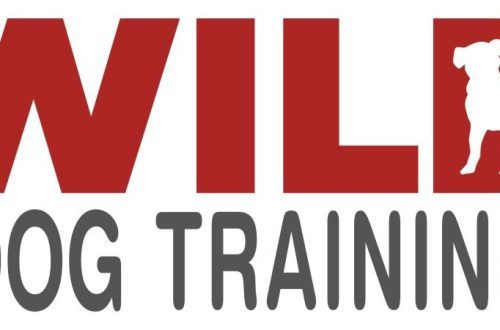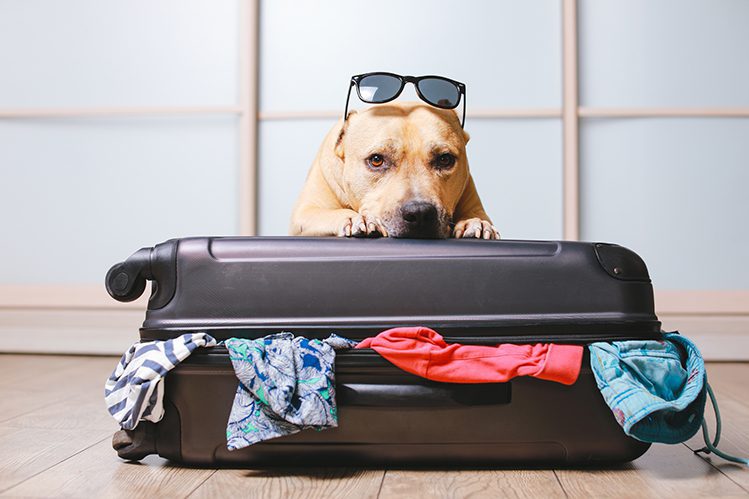
How to transport a large dog?
Are you traveling with a dog? Yes, and not with a toy terrier, but with a Great Dane? How to organize everything? What transport to choose? Are there carriers for large and giant dogs? About this and about a couple of useful life hacks in our article.
The smaller and calmer the pet, the easier it is to transport it. A small dog can easily fit in a compact container, it will not be a problem when traveling on a bus, you can even take it with you on an airplane. With large and giant breeds, everything is more difficult, but there are always options.

Contents
- What type of transport to choose?
- Transportation of a large dog in a car: basic rules
- Transportation of a large dog on a train: basic rules
- Transportation of a large dog on an airplane: basic rules
- Urban public transport: basic rules
- Carriers for large dogs
- What documents are needed to transport a dog?
- If you have a guide dog
- Life hacks for everyone
What type of transport to choose?
The best mode of transport for transporting a large dog is your personal car. Firstly, you can accustom your pet to your car in advance and he will feel calm during the journey. Secondly, only your company will be in your car, and the dog will not cause trouble to strangers. Thirdly, you can organize the space in the cabin at your own discretion: purchase a carrier, a hammock, restrictive barriers, clamps and other accessories that will make the trip convenient and safe for everyone.
The second most convenient option is a train. On the train, the dog can be transported in a special vestibule or in a separate compartment. Traveling in a compartment is much more pleasant. For most dogs, transportation in the tambour can be a huge stress: inappropriate temperature, strangers, intrusive smells, loud noise … But the main thing is that there will not be a beloved owner next to the dog who can console and support.
It is much more comfortable to buy all compartments. You can stay in it alone with your dog, or bring along friends and family members who don’t mind being next to a four-legged dog. It is convenient in a compartment with a dog: she will be able to stretch out on the floor, will not interfere with other passengers, and she will be calm next to the owner.
Aircraft is the ideal way to get from point A to point B in the shortest amount of time. When it comes to traveling long distances, there is no more convenient transport. However, airline regulations prohibit the transportation of large dogs in the cabin. The airline may offer you to check in your pet in the baggage compartment, but this scenario is not suitable for everyone. Transportation in the luggage compartment is accompanied by risks for the pet. Especially for brachycephalic dogs, which due to their physiology are prone to cardiovascular and respiratory problems. Some airlines prohibit the carriage of such dogs. Be careful: different carriers put forward different requirements and you need to familiarize yourself with them in advance. Even if you decide to transport your pet in the luggage compartment, it may not be able to carry the weight. Dogs weighing more than 50kg including carrier may not be allowed on board.
What other options might there be? You can contact companywho specialize in the transport of animals. As a means of transport, for example, buses or fixed-route taxis can act. The dog travels with an accompanying person or alone, if such a need arises. Transport can be equipped with special enclosures for animals, a special escort can work on the route. He will monitor the comfort of pets, feed and water them, monitor their condition. Learn what service a particular carrier offers.
If you are planning to bring your dog to taxi, check in advance whether the company will be able to fulfill your order. You can’t just call a taxi. Seeing a huge four-legged passenger, the driver is likely to refuse your trip – and he will be right. The dog can interfere with the driver, stain the car and leave behind allergens that can cause reactions in the next passengers. In addition, the driver may, in principle, be afraid of dogs – and no one will like such a trip.
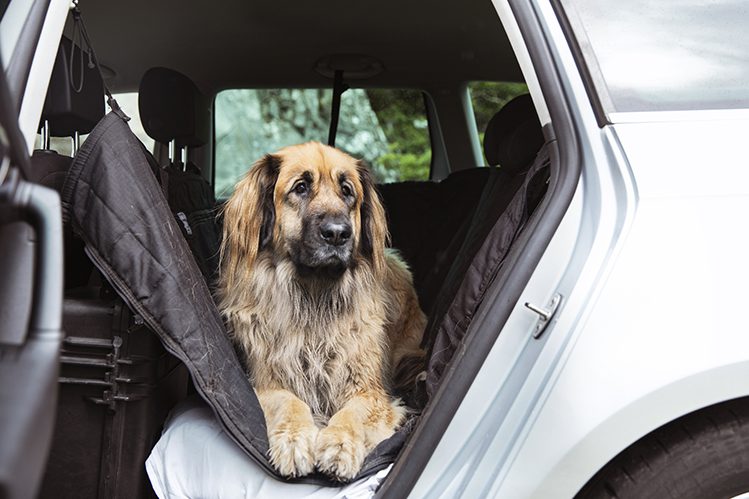
Transportation of a large dog in a car: basic rules
The dog should not be able to interfere with the driver and block the view.
A restless or very active dog is best transported in a special carrier. The carrier must be secured so that it does not tip over during sudden braking. If the carrying dimensions allow, it can be placed in the luggage compartment or at the feet of passengers.
In a personal car, a dog can be transported without a carrier. She can sit in the rear seats or at the feet of passengers (not the driver). It is not recommended to put a dog in the front seat, even if it is very obedient and used to the car. Different situations may arise on the road, and the dog may behave outside the box, interfere with the driver. For the same reason, it’s best not to let your dog stick its head out of the car window: it can get overexcited by the sights rushing past, try to get out of the car, or rush to the owner to cuddle.
When traveling, it is convenient to use a special car hammock. The hammock is placed between the back of the front seats and the rear seats. It creates a comfortable space for the dog, does not allow it to crawl between the seats and interfere with the driver, protects the seats from hair, saliva and claws. An alternative to a hammock to protect the interior is special covers for chairs.
- The most reliable option is to purchase autobarriers. These are special removable lattice walls that are attached between the seats. With their help, you can limit the space for the dog and be sure that at the most crucial moment your mastiff will suddenly not be on your lap.
Transportation of a large dog on a train: basic rules
What dog is considered large according to the rules of Russian Railways? If the dog does not fit into the carrier, the dimensions of which in the sum of three dimensions are up to 180 cm, it is considered large.
On the train, a dog can be transported in a special vestibule or in a separate compartment.
Transportation of a dog in the vestibule is paid separately. You will need to buy a ticket not only for yourself, but also for your pet. The price depends on the distance of the route.
A compartment for transporting a dog will have to be fully redeemed. In this case, you do not need to pay extra for a dog.
With you in the compartment may be your friends or family members who do not mind traveling with a pet. The number of passengers must not exceed the number of seats in a compartment.
It is not possible to transport dogs in reserved seat, seated carriages, as well as in superior comfort compartments.
Large dogs must be muzzled and on a leash.
The dog is not allowed to be put on the shelf, even if you have a bedding. But the litter will still be needed to equip the pet with a comfortable place on the floor.
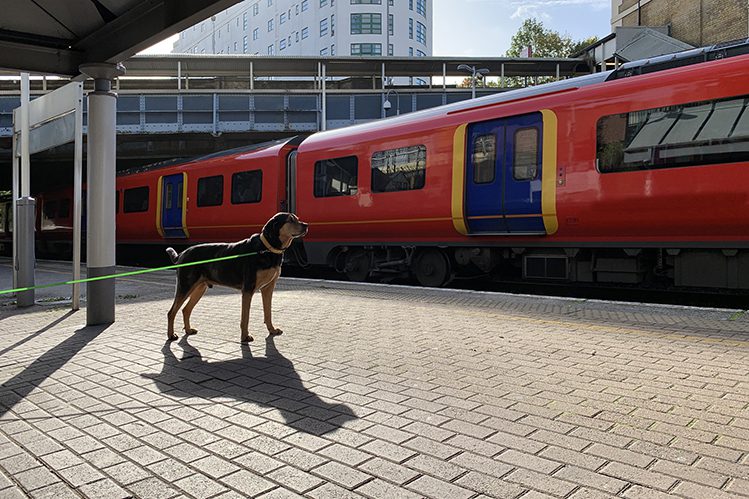
Transportation of a large dog on an airplane: basic rules
Transportation of a dog on an airplane is paid separately, according to the baggage rate.
Each air carrier sets its own requirements, so the rules for transporting animals can vary greatly. You need to know about them in advance, before planning a trip.
Only small dogs are allowed in the cabin of the aircraft if the combined weight of the pet and the carrier does not exceed 8 kg, and the sum of the length, width and height of the carrier is up to 115 cm.
Sometimes the company puts restrictions not only on weight, but also on age. For example, only puppies are allowed in the salon.
Large dogs are transported in the luggage compartment as non-standard cargo. To do this, the dog is placed in a strong container or cage with a reliable locking mechanism.
The company may prohibit the carriage of brachycephalic dogs (i.e. those with very short or flat muzzles). These pets have an increased risk of cardiovascular disease and respiratory problems.
The container for transportation must comply with the requirements of the company. Study them beforehand and make sure your container is suitable. It will be frustrating if you are not allowed on board due to inappropriate carrying. In stores, look for MPS carriers with a yellow sticker: these are standardized carriers for air travel.
Urban public transport: basic rules
The rules for transporting a dog in public transport are established by the administration of the locality. With the transportation of small pets, as a rule, there are no problems. You put your dog in a carrier and can carry it almost anywhere as hand luggage.
With large dogs, the situation is not so pleasant. Passage with a large dog is prohibited in the metro, and you may not be allowed into the minibus and bus due to lack of space. The presence of a muzzle, a leash and good manners of a pet will increase your chances of a successful trip.
In suburban trains, a large dog can be transported in the vestibule. She must be on a leash and muzzled, always with an escort. Pet transportation is paid separately. An important rule: only two dogs can pass in one carriage.
To travel by city municipal transport, veterinary documents for a pet are not required.
Carriers for large dogs
Dog carriers come in different sizes. In pet stores, you can buy a container for both Chihuahua and Collie. For a large dog, you need to choose a large carrier. For MPS, this is the SKUDO container for large breeds 105x73x76h: it is suitable for dogs weighing up to 45 kg.
Choose strong, stable, secure containers with a metal door, latches and additional fasteners, with ventilation holes in which the dog can not stick his muzzle or paws. The carrier must have a rigid structure, keep its shape: it is safer for the dog. A fold-out handle and document pockets make your journey even more convenient.
If you are looking for a container for an aircraft, look for models with a special mark “suitable for air travel”. MPS has yellow stickers.
Check with the shipping company in advance about the requirements for carrying, so as not to make a mistake with the purchase.
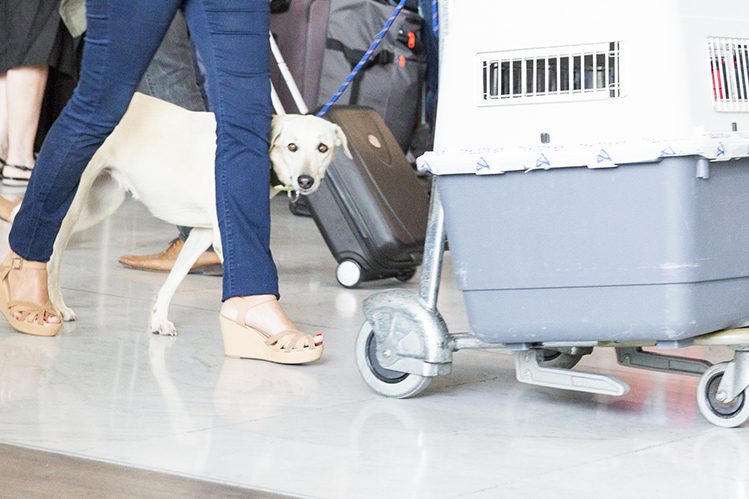
What documents are needed to transport a dog?
Appropriate carrying and transportation are not all you need to travel. The dog must have a set of documents. This is at least a veterinary passport with up-to-date vaccination records and a veterinary certificate in form No. 4, which is valid only 5 days from the date of issue. To travel to European countries, the dog will have to be microchipped. Don’t worry, it’s not a difficult procedure. It would be great if it became mandatory in our country. If a pet is lost, the chip will help identify the dog.
Find out in advance what documents are required for a dog in the country you are traveling to and at the borders you will be crossing. How long are certificates and vaccination marks valid? This will help you avoid unpleasant surprises along the way.
If you have a guide dog
Guide dogs are a separate category of animals for which different rules apply. In this case, the dog has a different status. She is perceived not just as a pet, but as a guide for the disabled. Guide dogs are free of charge, and they can travel with the owner on all types of public transport. If we are talking about transportation over long distances, you need to familiarize yourself with the rules for transporting animals in a particular company. They may vary depending on the carrier.
The guide dog travels on a leash and in a muzzle, at the feet of the owner. The passenger must have a document on disability and a document for a dog confirming the status of a handler.
Life hacks for everyone
- Step #1. When planning a trip, contact the carrier in advance and ask in detail about all the conditions. Check the rules for transporting animals, weight and age restrictions, requirements for carrying and documents for a pet.
No matter how many useful articles you read, the carrier can change the rules at its discretion. It will be frustrating to hear about changes in place. Unfortunately, travel disruptions due to non-compliance with the rules are not uncommon.
- Step #2. If you are going to another country, check its legislation. What documents are needed for a pet so that he can enter this country? What vaccinations should he have? How much are they valid? What about pest control marks? Is a chip needed? Specify all this in advance and insure yourself against unpleasant surprises.
Well, now it remains to pack your bags! Be sure to bring two bowls for your pet, food, the most delicious treats and his favorite toys. Bon Voyage!





